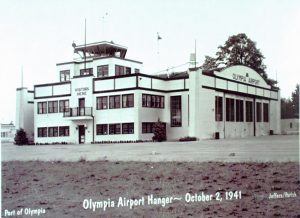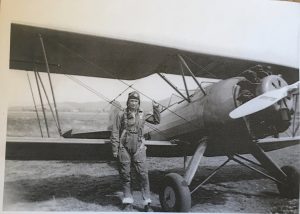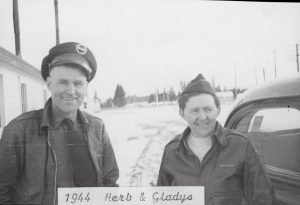Local airports are home to more than just hobbyist pilots and fuel stops between bigger cities. Thurston County’s Olympia Regional Airport offers flight instruction and aircraft maintenance, and serves as a base for air ambulance services, charters, aerial firefighting, tourism, fish and wildlife enforcement, wildlife restoration programs, and the aviation divisions of Washington State Patrol and Department of Transportation. Over the years, the airport has played a valuable role within the bustling Port of Olympia family.
Aviation and Research at Olympia Regional Airport

Warren Hendrickson, airport senior manager, joined the team July 18, 2022 after working in aviation his entire professional life. “This position is the capstone to a very rewarding career,” says Hendrickson.
He explains that the Olympia Regional Airport is a general aviation airport, or one that supports all civil aviation aircraft operations with the exception of commercial air transport. As one of only three Thurston County airports available for public use – and the only one with paved runways – it busily handles transportation for businesses, organ transplants, search and rescue operations, disaster response, crop dusting, sightseeing and volunteer organizations like Angel Flight or Pilots N Paws. It is also the home base for the governor’s airplane.
The airport additionally serves a scientific purpose. It is home to a Global Positioning System (GPS) research station in support of the Central Washington University Pacific Northwest Geodetic Array. Their collected data is used in support of highway, bridge, and dam failure research to ensure preventative measures are in place before tragedy strikes.
Olympia Airport Receives Federal Funding

The Olympia Regional Airport has been recognized by the Federal Aviation Administration as critical to the National Plan for Integrated Airport Systems, explains Hendrickson. This distinction allows the airport to receive federal funding for eligible projects. These funds are sourced from aviation user fees, not taxes, and provide 90% of the required funding for planning and capital projects.
The airport also shares a footprint with the New Market Industrial Campus and Cleanwater Center business and industrial parks. Funds these business leases bring in ensure the airport is a positive revenue generator for the Port. Both are localized job creators welcoming new industries and small businesses to the region.
Speaking of footprints, Olympia Regional Airport grounds are habitat to three endangered species, says Hendrickson. “These are the Olympia pocket gopher, the streaked horned lark, and the Oregon spotted frog. The Bush Prairie Habitat Conservation Plan being developed with the City of Tumwater and the United States Fish and Wildlife Service will provide long term protection for these species as well as mitigate for the impacts of ongoing development, maintenance and other activities.”
Historical Pilots at Olympia Regional Airport
Over the years, the airport has seen its share of spirited aviators who incorporated pioneer spirit and budding technologies to keep our community strong.

Ross Dye (1907-1997): A local barnstormer, he co-owned the first private airplane in Olympia in 1927. Dye taught flying as part of Olympia Airways and later set up a flying service and school where he trained several Olympians as part of the Olympia Air Transport Service in the 1930s. He was part of the pilot training school at the airport with St. Martin University before World War II.
Gwin F. Hicks (1910-2000): A Lacey native, Hicks started flying in the 1920s before joining the Department of Highways in the 1930s. There he managed the state’s first plane before becoming airport manager in 1937. In the late 1930s, he and wife Vivian, amongst others, helped establish Civil Aeronautics Authority (CAA) and Civilian Pilot Training (CPT) Programs with St. Martin’s College. Hicks was instrumental in preserving early Olympia aviation history through interviews and the Gwin Hicks collection at the Lacey Museum.
Vivian Myrtle Ingram Hicks (1907-1977): Wife of Gwin Hicks, she soloed herself in 1928 and was the first woman in Southwest Washington to earn her pilot’s license in November 1931. A lifelong advocate for air travel, she worked in administration and as a liaison for the CAA, CPT and War Training Service (WTS).

Gladys Dawson Buroker (1914-2002): This Ferndale, Washington native began to fly planes in 1932, when she graduated from high school. She parachuted, wing-walked and was an avid motorcyclist. Gladys and husband Herb Buroker started working at the Olympia Regional Airport in 1937 with Herb also teaching mechanics at Olympia High School. Gladys later became a nurse but remained active in aviation including giving rides and instruction in hot air balloons, biplanes and gliders.
Brigadier General Jack Cram (1906-1998): Cram became the first pilot for the state with the Washington State Highway Department and was hired as the first manager of the Olympia Airport in 1935 where he built a hangar and operated a flying school. He began active military duty in 1941 and had a storied career as a pilot in World War II and the Korean War. He was awarded the Navy Cross, the Legion of Merit, the Distinguished Flying Cross and Air Medal.
Olympia Regional Airport
The Olympia Regional Airport has shaped our community in many ways. Ross Dye took to the air alongside Charles Lindbergh as he passed over the Capitol Dome in 1927. The Olympic Flight Museum still hosts endless fieldtrips for students of all ages. You can even watch the Airport Webcam to view airport weather or track incoming and outbound planes.
The years ahead will clearly bring new technology to the skies with advancements in electric aviation, the elimination of leaded aviation fuel, and the possibility of offering regional commercial service at the airport. Read how these developments are planned for incorporation in the ongoing Airport Master Plan Update and learn how to get engaged on the Port of Olympia’s website. As Washington state’s capitol city airport, Olympia Regional Airport can be counted on to serve the community’s aviation needs in a safe, efficient, and responsible manner for years to come.
Sponsored

















































